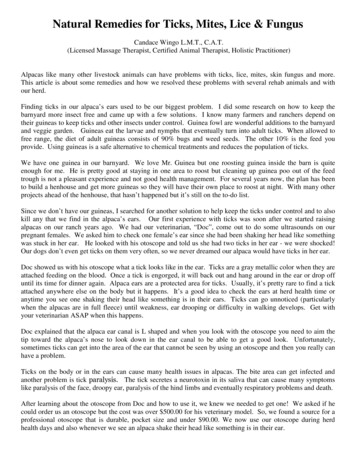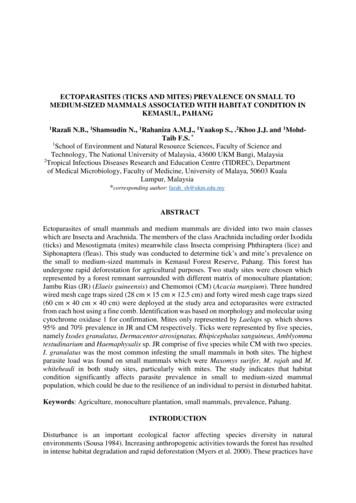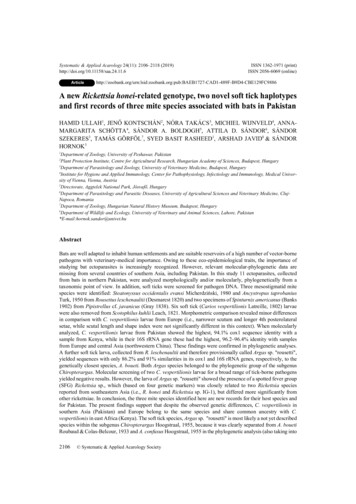
Transcription
Natural Remedies for Ticks, Mites, Lice & FungusCandace Wingo L.M.T., C.A.T.(Licensed Massage Therapist, Certified Animal Therapist, Holistic Practitioner)Alpacas like many other livestock animals can have problems with ticks, lice, mites, skin fungus and more.This article is about some remedies and how we resolved these problems with several rehab animals and withour herd.Finding ticks in our alpaca’s ears used to be our biggest problem. I did some research on how to keep thebarnyard more insect free and came up with a few solutions. I know many farmers and ranchers depend ontheir guineas to keep ticks and other insects under control. Guinea fowl are wonderful additions to the barnyardand veggie garden. Guineas eat the larvae and nymphs that eventually turn into adult ticks. When allowed tofree range, the diet of adult guineas consists of 90% bugs and weed seeds. The other 10% is the feed youprovide. Using guineas is a safe alternative to chemical treatments and reduces the population of ticks.We have one guinea in our barnyard. We love Mr. Guinea but one roosting guinea inside the barn is quiteenough for me. He is pretty good at staying in one area to roost but cleaning up guinea poo out of the feedtrough is not a pleasant experience and not good health management. For several years now, the plan has beento build a henhouse and get more guineas so they will have their own place to roost at night. With many otherprojects ahead of the henhouse, that hasn’t happened but it’s still on the to-do list.Since we don’t have our guineas, I searched for another solution to help keep the ticks under control and to alsokill any that we find in the alpaca’s ears. Our first experience with ticks was soon after we started raisingalpacas on our ranch years ago. We had our veterinarian, “Doc”, come out to do some ultrasounds on ourpregnant females. We asked him to check one female’s ear since she had been shaking her head like somethingwas stuck in her ear. He looked with his otoscope and told us she had two ticks in her ear - we were shocked!Our dogs don’t even get ticks on them very often, so we never dreamed our alpaca would have ticks in her ear.Doc showed us with his otoscope what a tick looks like in the ear. Ticks are a gray metallic color when they areattached feeding on the blood. Once a tick is engorged, it will back out and hang around in the ear or drop offuntil its time for dinner again. Alpaca ears are a protected area for ticks. Usually, it’s pretty rare to find a tickattached anywhere else on the body but it happens. It’s a good idea to check the ears at herd health time oranytime you see one shaking their head like something is in their ears. Ticks can go unnoticed (particularlywhen the alpacas are in full fleece) until weakness, ear drooping or difficulty in walking develops. Get withyour veterinarian ASAP when this happens.Doc explained that the alpaca ear canal is L shaped and when you look with the otoscope you need to aim thetip toward the alpaca’s nose to look down in the ear canal to be able to get a good look. Unfortunately,sometimes ticks can get into the area of the ear that cannot be seen by using an otoscope and then you really canhave a problem.Ticks on the body or in the ears can cause many health issues in alpacas. The bite area can get infected andanother problem is tick paralysis. The tick secretes a neurotoxin in its saliva that can cause many symptomslike paralysis of the face, droopy ear, paralysis of the hind limbs and eventually respiratory problems and death.After learning about the otoscope from Doc and how to use it, we knew we needed to get one! We asked if hecould order us an otoscope but the cost was over 500.00 for his veterinary model. So, we found a source for aprofessional otoscope that is durable, pocket size and under 90.00. We now use our otoscope during herdhealth days and also whenever we see an alpaca shake their head like something is in their ear.
Since we were freaking out that our alpaca had ticks in her ear, we ask Doc, “How do we kill them”!!!! He toldus to squirt ½ cc Ivermectin in the ear to kill the ticks. We did and he rechecked a few days later and the tickswere dead and gone. I was very glad the ticks were gone but I didn’t like putting a chemical in her ear.That started the search for a natural solution to kill the ticks in the ears and I also wanted a good prevention forkeeping ticks out of their ears. I tried many herbal solutions that I mixed up with different things like tea treeoil, lavender oil, apple cider vinegar, calendula cream, etc. but nothing was working as well as I wanted.Then I found a cedar oil mixture – Alpaca & Llama Insect Spray. It’s a mixture of cedar oil and silane fluid(melted quartz rock). I liked the ingredients, so I called and talked with the company’s veterinarian and askedabout the use on pregnant and baby animals. He assured me that would not be a problem, so I tested it on ourherd of 70 alpacas. Yes, it does work and it prevents ticks in the ears for up to 2 weeks with one spray mistinto each ear. Not only does it kill the ticks in their ears but it helps the skin heal up inside the ear.This spray is non-toxic and safe to use on all animals except exotic birds since they are very sensitive tofragrances in contained areas. We use this spray on our dogs & barn cats too – it kills fleas immediately and isa great alternative for spot drop flea treatments that are toxic to our pets.Rehab case study:A pregnant female alpaca was brought to our ranch to rehab with facial paralysis & severe ear infection that shegot from ticks in her ear. After their veterinarian checked her out & put her on some meds, they neededsomeone to keep an eye on her. They also wanted us to do some natural therapies to help her along since shehad not been progressing very well.Her left ear was droopy flat and that side of her face had paralysis. Her lip drooped, which made her drool, andshe always had a wad of food & cud stuck in her cheek which needed to be cleaned out each day. I almost lostpart of my finger trying to clean the cud out of her mouth, so I learned quick to push the cud out by gentlypushing on the outside of her cheek. That worked better and the process became a gentle massage for that sideof her face & ear, which helped bring back circulation to the area.See pictures– One ear droopy and then recovery in the next picture.Therapies that we used for this female:1. We sprayed one mist of the Alpaca & Llama Insect Spray in her ear every other day to help the skin healin the ear.2. Twice a day – we top-dressed her feed with 1 scoop of the Animal Herbal Formula & 1 tablespoonliquid Silver Shield (colloidal silver) - to build & support her immune system.
3. She wore a magnet headache band (made for humans) around her neck to help with inflammation andopen up some blockages in that part of the body. (I use a lot of magnet therapy on humans and animalsbut I’ll save that topic for another article.)4. Daily massaged the face and ear to help with circulation.The good news is – after 3 weeks with these additional natural therapies, her ear infection healed, her ear wasupright, no more drooling or food stuck in her cheek and her facial paralysis was 90% gone. Years later theowners tell me she still has a little “droop” to her ear and face on occasion but not all the time. They now checktheir alpaca’s ears with an otoscope when needed and they also use the Alpaca & Llama Insect Spray as apreventative during tick season.Mites:Sometimes alpacas will have areas on their face where the fiber is missing or the nose has a little shiny spotwhere the fiber is gone. This could be a zinc deficiency or the animal has been rubbing their nose on a tree orfence post but it also could be mites or fungus. Your veterinarian can do a skin scraping to find out if you havemites or test for fungus or you can try a natural approach to see if that works first.If you see fungus on the skin and you find it quick enough, you can kill the fungus & the fiber will start growingback with healthy skin underneath pretty quick. See the picture showing fungus on one eyelid. I used a Q-tipdipped into the Alpaca & Llama Insect Spray solution and painted on the area once a day being careful not toget the solution in the eye. The next picture shows improvement in a few days and the fiber is starting to growback. If left untreated, this area would have become very crusty with thickened skin. If you see skin alreadycrusty and thick, scrub the area with something like Betadine and get that crusty skin off so you can treat thefungus underneath. It will clear up if you continue to scrub and treat. You can scrub with a toothbrush for areaslike the eyelid.Another skin condition is Ideopathic Nasal / Perioral Hyperkeratoxic Dermatitis or Munge. This conditionusually affects the lips and nose. Munge lesions include thickening and cracking of the skin at the corners ofthe mouth with some crusty scales & thicker skin on the lips and nose. Munge may be the results of acompromised immune system, bacterial infection, viral infection, fungal infection, mites or constant grazing inwet grass.The good news is that many farms & ranches have used the Alpaca & Llama Insect Spray to get rid of mites,fungus and munge --- it works! If a skin condition has been there for years with thick, slick skin – you maynever be able to clear it up but it’s worth a try. Some mite infestations, fungus conditions & munge take longerto get rid of than others but the spray is safe to use for you and the animals.
See the picture showing what was believed to be a zinc deficiency but it turned out to be mites instead.There are three types of mange mites that can infest alpacas:1. sarcoptic mites2. chorioptic mites3. psoroptic mitesSarcoptic mites are serious when found on your alpacas. These mites like to burrow into the skin usuallyaround areas on the face or ears but can spread to other parts of the body. Symptoms are crusty areas of theskin that thicken and wrinkle and the fiber falls out. I worked with a rehab animal from another ranch that had asevere infestation of this mite on her ears and the back of her head. The edges of the ears were not smooth butwrinkled and the fiber was gone. I sprayed the Alpaca & Llama Insect Spray on the ears and back of the head,rubbing in the solution once a day. Always covering the eyes when spraying the solution on and around theface. Within a week the mites were gone and the hair was starting to grow back. This animal is still mite free,her ears feel normal along the edges and the ears are full fleeced again.Chorioptic mites don’t burrow into the skin and are usually found on the lower legs, between the toes and canspread to the hindquarters. Usually you don’t see a skin thickening with this mite but will see the animalscratching, see scabs on the skin and lesions between the toes. The Alpaca & Llama Insect Spray will kill theseguys too and help the skin heal. Spray liberally the infested areas at least once a day until you see results thatthe skin is clearing up.Psoroptic mites don’t burrow into the skin but still pierce the skin to feed on lymph fluids just like the other twotypes of mites. They cause irritation, dry and crusty lesions on the skin that itch. These lesions weaken the fibercausing it to fall out in areas. Usually these mites are found in full fleece areas like the shoulders, back & tailbut can also be found in the ears. You may see a waxy residue in the ears, lack of coordination and headshaking in the animal that has this mite in their ears. Your veterinarian can swab the ears to identify the mite.Symptoms of mites: Crusty lesions on the skin.Thickened skin with scabs.Fiber falling out in areas.Wrinkles along the edges of the ears and on the skin.Animal itchy and scratching at the ears or parts of the body.
Lesions between the toes.Weight loss.Head shaking.Waxy residue in the ears.Raw skin.Fiber missing on the nose and face.Sometimes Ivermectin injections are given to get rid of some of these mites but consult with your veterinarianon that.I’ve heard that some people use Witches Brew. I didn’t like the chemicals in the Witches Brew and if you useit, be sure you wear two pairs of gloves to prevent getting it on your skin! I’ve also heard of a spot droptreatment that is being used but it sounds pretty toxic to me. I found the Alpaca & Llama Insect Spray worksand it’s safe if I get it on my skin; so I stay away from all of those chemicals and injections that can knock theanimal’s immune system down even more.Here is the recipe for Witches Brew- (Dr. Evan’s Camelid Skin Solution is the same thing)2/3 pint mineral oil1/5 pint DMSO8 ml Ivermectin5 cc Gentamycin (50 mg per ml)Recipe found at - blems.aspxMites on NoseMites on nose gone – several days laterhair is growing backLice:There are two kinds of lice that attack alpacas:1. The sucking louse which feeds entirely on blood and can cause anemia.2. The biting louse which feast on hair and debris on the alpaca's skin surface.Signs to look for if you think your alpaca might have lice: Rubbing or scratching the affected area. Dandruff Fiber loss in large patches. Small specs that look like sand but move when disrupted.
Lice can be a problem for alpacas and especially at shearing time. Shearing day is going along good and thensomeone yells, “Lice on this one!” Biting lice are white or light tan and look like small specs of sand that movewhen disrupted. Many people use Adams Flea Mist that they spray all over the area where they’ve seen thelice. Don’t use it! It smells terrible and is very toxic to you and the animal!What’s the natural approach?The best thing I’ve found is the Alpaca & Llama Insect Spray. Kills the lice instantly. Safe for the animals – pregnant and cria too. Safe for you. It smells like a cedar chest and not chemicals. Spray a quick mist across the open bag of fiber to keep moths away while the fiber is airing out. Spray across the alpaca’s back after shearing to keep flies and mosquitoes off until they grow somefiber back. You can spray on yourself to repel flies, mosquitoes, chiggers, etc.If you suspect that your alpaca has lice before shearing time, treat the animal with the Alpaca & Llama InsectSpray – it kills the lice immediately. The fiber smells like a cedar chest so no problem with that and it doesn’tstain the fiber. Usually you spray the areas inside the back thighs, armpit area, base of the neck and the tail orwhere ever you need it. I would spray those areas every day for a few days to make sure you get it all.Some people treat the alpacas with a topical dust or pour on medication. Ivomec is used for the sucking lice butis not effective for the biting lice. Do your research on this – these are all toxic.Side Note: There is a ranch that makes alpaca woven rugs – they lightly spray the rugs with the Alpaca &Llama Insect Spray before shipping to customers and when boxed for storage. It doesn’t stain and it smellsgood. You can spray in your cabinets to kill & repel spiders, silver fish & other insects. I spray it in thedisplay shelves and cabinets where I have alpaca garments for sale as a repellant for moths. The Alpaca &Llama Insect Spray has many uses. I definitely am very impressed with this product!The information in this article and any product mentioned is not intended to diagnose, treat or cure any animaland is not intended to replace the advice of your veterinarian. I have found these therapies and products workfor our herd of alpacas. When I work with owners & their animals I work closely with their veterinarian as theiragent. Always consult with your veterinarian when your animal is ill and consider using some natural therapiesand products to compliment their care.Where to order any products mentioned in the article: Pocket size otoscope - www.alpacasALLnaturale.com Alpaca & Llama Insect Spray - http://www.alpacallama-insectspray.com/ Animal Herbal Formula - www.alpacasALLnaturale.com Silver Shield (natural antibiotic) - www.alpacasALLnaturale.comAlpacas Afield On-Line Magazine – March 2010 issue
fragrances in contained areas. We use this spray on our dogs & barn cats too - it kills fleas immediately and is a great alternative for spot drop flea treatments that are toxic to our pets. Rehab case study: A pregnant female alpaca was brought to our ranch to rehab with facial paralysis & severe ear infection that she got from ticks in her ear.










